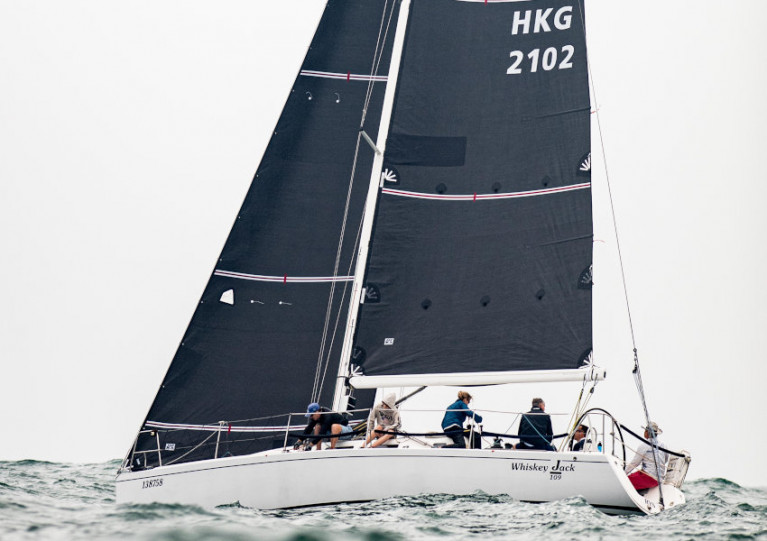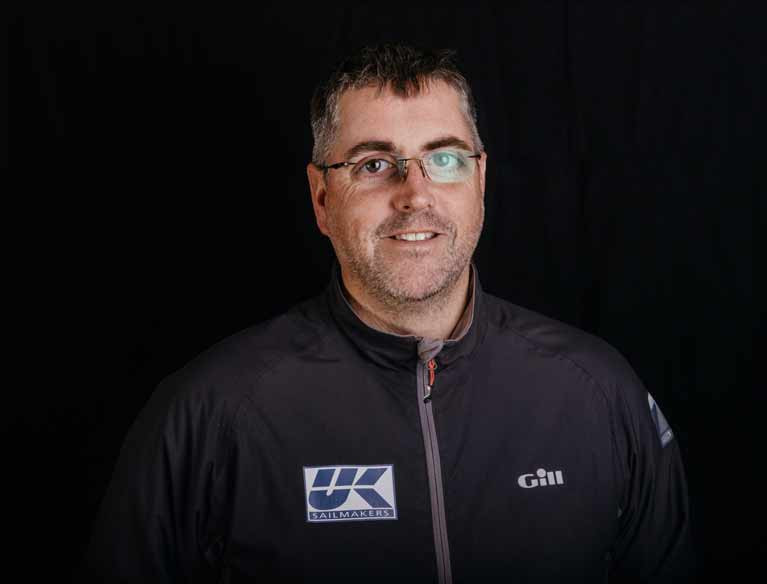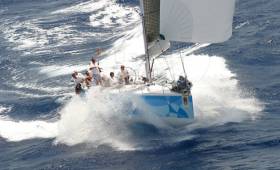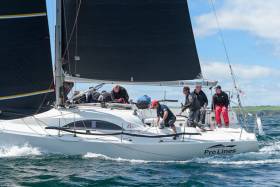Displaying items by tag: Barry Hayes
Sailmaking Changes After 50 Years in Crosshaven
After 50 years, there is a major change in sailmaking at Crosshaven, Cork Harbour’s dominant sailing centre.
.
Outside the village, the loft associated with the legendary Des McWilliams and family is no longer a sailmaking centre.
Barry Hayes and his wife, Claire Morgan, who took over the business seven years ago, have moved sailmaking to a new loft at Carrigaline, a few kilometres away. In addition, they have opened the first sailing shop in the village of Crosshaven itself, an impressive premises looking out onto Cork Harbour, the marinas and the RCYC sailing grounds.
 The new McWilliam Sailing Shop in Crosshaven was opened on Friday, November 17, 2023. The impressive premises looks out onto Cork Harbour
The new McWilliam Sailing Shop in Crosshaven was opened on Friday, November 17, 2023. The impressive premises looks out onto Cork Harbour
For this week’s Podcast, I discussed these changes at Sailmakers at The Square, Crosshaven, with Barry Hayes, who did not start his working life as a sailmaker - he was making chocolate when Des McWilliam convinced him to switch careers.

We discuss the modern changes in designing and manufacturing sails. He describes making canvas sails in Hong Kong, the long-lasting effect that had on his hands and how today, sails made from many different fabrics are also made to last longer.

Listen to the podcast and check out the photo gallery of the Sailmakers at The Square launch in Crosshaven below.
Photo Gallery: Sailmakers at The Square Launch in Crosshaven
In light of the coronavirus situation effecting Ireland, Afloat.ie got in touch with Barry Hayes from UK Sailmakers Ireland, who has lived in three continents, to share his experience in Asia and what’s going on with Covid-19 in Hong Kong’s sailing community.
Barry says: “Having lived in HK for so long, I can tell you they have vast experience with viruses! For example, HK has had influenza, swine flu and the SARS virus. They hit very hard in HK and the people responded to it.
“Yes, clubs closed and people lost jobs. Racing stopped for a short time. It returned and they recovered quickly.
This year, Covid-19 really hit home in Hong Kong around Chinese New Year festivities on 24 January. “When HK started to go into lockdown schools were closed, and still are. From there all racing was stopped and the clubs closed.
“But this time the HK government felt it was better to keep the clubs going and get people out sailing. So they didn’t let the clubs stay closed for long — pushing them to reopen as soon as a low in the virus came so people got out and got active in the sun.
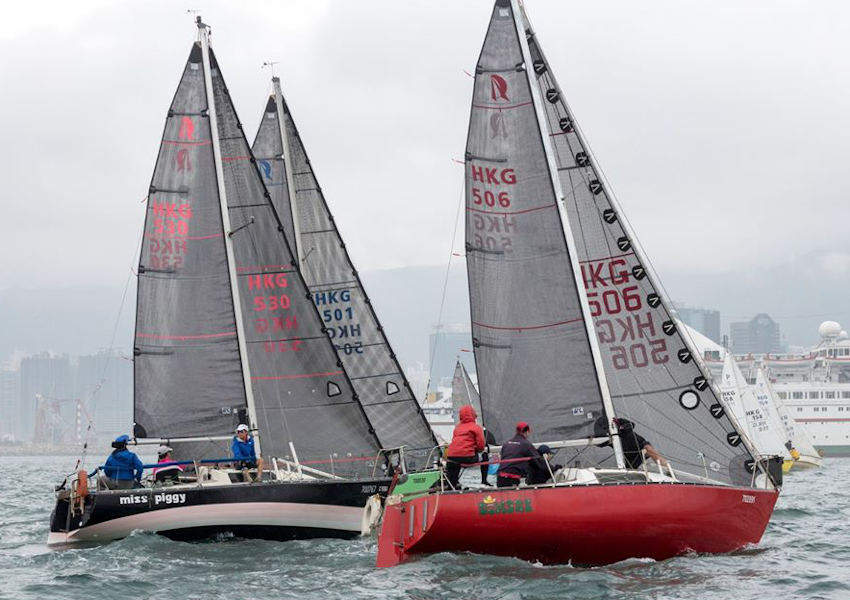 Racing in Kowloon Bay at St James’ Place Ladies Helm Day on 8 March | Photo: RHKYC/Guy Nowell
Racing in Kowloon Bay at St James’ Place Ladies Helm Day on 8 March | Photo: RHKYC/Guy Nowell
The upside of this, Barry says, is that “there is light at the end of the tunnel”.
“Last weekend HK returned to full racing. Just eight weeks after the virus hit the hardest. They held the Hong Kong IRC Nationals on 14-15 March.
“This virus will affect us but we will rebound. I am sure, having lived in both countries, we need to work super hard to reduce the contact between humans as much as we can. And Ireland seems to be working hard on doing this.
“I know in the short term it seems impossible, but I can tell you from experience we will be back racing with a delayed season.
One of the boats sailing in last week’s HK IRC nationals was Nick Southward’s modified J109, Whiskey Jack.
 Whiskey Jack on day 3 of the Hong Kong IRC Nationals | Photo: ABC/Takumi Furuichi
Whiskey Jack on day 3 of the Hong Kong IRC Nationals | Photo: ABC/Takumi Furuichi
Nick, of the Royal Hong Kong Yacht Club and who will be chartering Imp for Cork Week, said that with border restrictions imposed early on, the infection rate in HK has been very slow.
“The threat now appears to be infections from people flooding back into HK from Europe and the US, but there is now a travel restriction in place and all who arrive have to go into a compulsory fourteen day quarantine at home. This monitored by a smart bracelet, an app and the police to ensure enforcement.”
Beyond that, Alex Johnson, manager of HK’s Aberdeen Yacht Club, reports that life is “sort of normal, but restricted in terms of what you can do”.
“The population is also very clued-up after SARS which really has helped to combat the virus. Everyone wears face masks, liberally uses hand sanitiser and luckily the toilet roll supply is now constant!
“HK is not out of the woods yet but the infection rate on the mainland has dropped dramatically so everyone is hopeful.”
Top Tips For the Bowman From UK Sailmakers Ireland
Barry Hayes from UK Sailmakers Ireland gives his top tips on how to be the best bowman
Any bowman worth his salt is fast on his feet, strong as an ox, and agile enough to climb the mast. The bowman is also the first to arrive at the boat and last to leave. Consider this about the bowman's role: there are very few changes or evolutions that happen during a race aft of the mast; they all happen forward in "bowman territory." The bowman must be prepared to deal with any call that's made from the afterguard and prepared to cope with any mishap that happens. Here are some top tips for a bowman spending the season on the pointy end.
 The bowman must be prepared to deal with any call that's made from the afterguard
The bowman must be prepared to deal with any call that's made from the afterguard
1. Wear the right clothes
If you don't go out suited and booted then you're coming home wet. A smock/spray top with closures at the collar, wrists, and waist-worn over layers is the best option to you stay dry. It's light and you can fit into any area without wearing a big offshore jacket. Non-adjustable trousers are a must as are shoes that stick to the deck. (Never consider going barefoot!). Test the shoes well before buying. A soft rubber sole is best, and boots with gaiters are the best option for offshore. Most of all, have dry socks if you're wearing shoes or boots.
 Spinlock harness
Spinlock harness
2. Must-have gear
The best harness in the business is a rock-climbing harness. Which you can get from Spinlock. These are light and simple to use. And excellent on the backs of your legs as they are wide. It's also vital to have hanging from your harness:
- A Leatherman skeletool
- An aluminium fid for spiking snap shackles
- soft shackles (different sizes)
- A roll of rigging tape
Going offshore, I prefer to wear a drysuit rather than traditional foul weather gear. I unzip it when I am below, and I'm always dry on deck. It's quick and straightforward and you can be on deck in seconds. A good quality suit means you can get out on the bow and now worry at all about being wet in any shape or form. They fit well with the latest life jackets.
3. Prep your boat
A good bowman will be first on the boat and last off, so he's ready for the next day's sailing. It's a bowman's job to check that all your luff tapes are stacked correctly and that the spinnakers are packed and prepared to go. Clean any furlers, check running rigging, and get it all prepped and ready before the rest of the crew arrives to a clear boat.
 It's a bowman's job to check that all your luff tapes are stacked correctly and that the spinnakers are packed and prepared to go
It's a bowman's job to check that all your luff tapes are stacked correctly and that the spinnakers are packed and prepared to go
4. Before the start
Have a thorough conversation with the tactician and helm well before the guns start firing. Review your starting sequence hand signals. Discuss the course, work out what sails will be needed, when and why. Getting angles for these sails will also help in terms of stacking sails below and pre-setting leads on the deck. If you're going upwind then changing to a code zero and later on to an Asym it will dictate a particular bow choreography. And those steps are up to you to take as the bowman. Perhaps you have the code zero plugged into starboard, and the kite plugged into port before the race has even started; you've already discussed this with the afterguard. I always try and hoist my code zero to windward and get it set ready to go before the start drop it back down, available for the first mark.
5. The start
Your job is to work with the helm and tactician to get the boat into the best position possible (and not over the line) when the gun goes off. Getting a good start is 90% of the race. Having clear communication with the helm is critical. With clear eye contact (tell the crew on the rail to hike out), hand signals are crucial if you don't have a headset on which are very common on big boats these days. Finger pointing up for come up, pointing down for down, fist for hold, hand opening for ease, hand closing for tighten. You need to know your boat lengths; practice a few approaches and get your lay lines and line sights before the start.
 The least amount of time spent on a bow the better; keep your eyes open and focus on your job
The least amount of time spent on a bow the better; keep your eyes open and focus on your job
6. Plan ahead
Before you rush to deal with something that comes up unexpectedly, think ahead about what needs to be done and be prepared. The least amount of time spent on a bow the better; keep your eyes open and focus on your job. Most pro bowmen spend less than 1.40 seconds on the bow in any windward-leeward race; aim for this target. Plan ahead, do quickly what needs to be done and get off the bow.
7. Always hold on
Nothing in this job is worth your life. It's great fun, but being clipped on with a good life jacket is worth everything. I use a carabiner with a short strop to my harness when I am working in heavy weather. I can quickly clip on and not worry about being washed away by a big wave.
8. Always look up
Whichever boat you're on, masthead or fractional, fast or classic, take time to learn which halyards are going where, make sure they are free to run. Make a drawing and determine which halyards do what with which sail like a 2:1 code zero halyard. If you cross a halyard in a change, then don't waste time uncrossing it; instead plan your next sail change so you can uncross it. I always leave the spinnakers halyards on a 2 ft strop higher up off the deck then the genoa halyards whereby they never get mixed up at night when you go to get one.
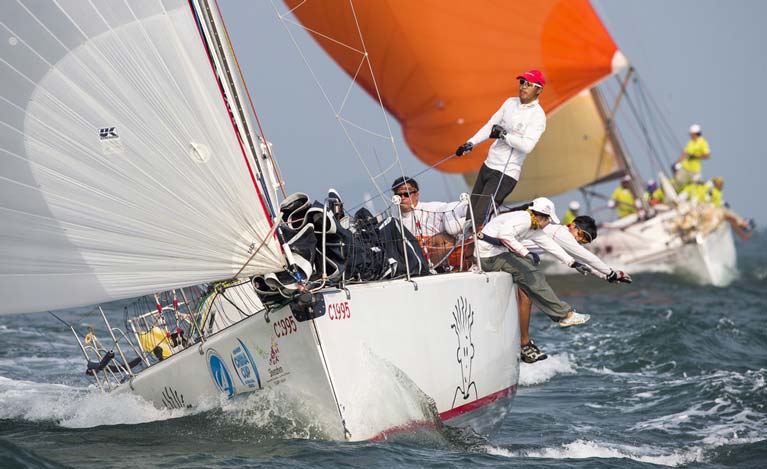 Working with people without shouting is the objective
Working with people without shouting is the objective
9. Communication is key to your job
Working with people without shouting is the objective. I always call the name of the person you want to address before you tell him or her what to do. If you say, Bob, (pause till he's looking at you) ease the tackline," is much more effective communication. Plus (theoretically) only Bob will leave the rail to ease the tackline and not half of the crew!
10. Understand how vital the pit person is to a bowman's success
There is a secret kept between the bow and the pit: they run the boat. The afterguard may point the boat in one direction or the other, but the manoeuvres don't work unless the bow and pit are working in concert. Having a very tight bond with your pit person is key to your role.
Remember, be prepared, anticipate, have your gear ready, stay in control of "your bow," and communicate effectively, no race is won without a bowman.
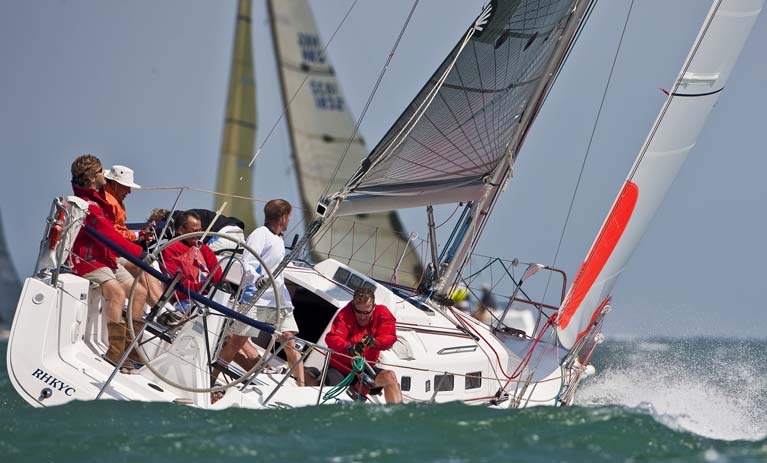 Manoeuvres don't work unless the bow and pit are working in concert
Manoeuvres don't work unless the bow and pit are working in concert
Barry Hayes from UK Sailmakers Ireland is at the Royal St George Yacht Club on Dublin Bay to talk about sail trim and boat optimisation for cruiser-racers on January 30th.
Hayes worked as a sailmaker in Ireland for five years under Des McWilliam. He then worked in New York on the east coast for UK Sailmakers for four years and also in Hong Kong.
In 2017, Hayes purchased the sailing loft from McWilliam and today is the director of UK Sails Ireland.
Interestingly, the Cork Harbour based sailmaker is planning to split the RStGYC talk in half. The first session is on sail trim and the second half deals with deck gear, winches, servicing and maintenance plus layout with a hands-on workshop showing how to correctly and easily service winches.
Booking and further details here
UK Sailmakers’ Barry Hayes In Howth Next Thursday For First In New Series On Top Tips For Sailors
Barry Hayes from UK Sailmakers Ireland begins a new series of talks with Top Tips For Sailors next Thursday 16 January at Howth Yacht Club from 7.30pm.
Members and guests alike are welcome to attend the two-part session which will cover both optimisation for racing or cruising vessels, and learning how to service your deck hardware — overalls recommended.
Barry will also visit the Royal St George on Thursday 30 January (time TBC) and Kinsale Yacht Club on Thursday 13 February at 7.30pm.

Four Time Olympian Mark Mansfield Joins UK Sailmakers Ireland
The new owners of Cork Harbour based UK Sailmakers Ireland have appointed Mark Mansfield as an agent and racing consultant to their Crosshaven loft.
Mansfield is a Royal Cork Yacht Club stalwart at the top end of sailing for many years — this season serving as tactician on a number of leading Irish keelboat campaigns, including a third consecutive win at the ICRA National Championships on the J109 Joker 2 that also won Boat of the Week at Dun Laoghaire Regatta.
Recently retired from his career in banking, Mansfield has been looking for a new business direction that puts his passion for sailing first.
And he feels that representing the quality product line of UK Sailmakers Ireland is a perfect fit.
“They have always had a strong reputation in Ireland and worldwide for many years and offer a very viable alternative — and with the new owners, will be priced very competitively,” Mansfield says.
He emphasises the quality product and backup, competitive prices and expertise in sail and rig set-ups that will make UK Sailmakers Ireland a new force in sail packages — and the number-one choice for your boat.
When it comes to his own credentials, Mansfield’s renown in the speed arena is in no doubt. A four-time Olympian (in Barcelona, Atlanta, Sydney and Athens) in the Star keelboat, Mansfield also notched a win in the Star Euros and a third place in the Star Worlds. He has also won National and Euro honours in Royal Cork's own 1720 sportsboat class.
In 2005 he returned to big boats, which he had previously helmed in the 1980s to a series of Admiral’s Cups, when he took the helm of the unforgettable Jump Juice in the Commodore’s Cup.
Switching to Sailing Class One in more recent years, Mansfield had found his calling as a title-winning tactician on boats such as Joker 2, Big Picture (Half Tonner) and Anchor Challenge (Quarter Tonner), as well as being a middleman in the Etchells and Dragon class.
He's also produced results offshore winning in class in the 2016 Round Ireland Race.
In these roles, Mansfield has built a solid reputation for his expertise in fast sail shapes and rig tuning. A move into sailmaking is therefore a natural progression — and a shrewd investment for UK Sailmakers Ireland continued growth.
Mansfield will be lending his strategic talents to the marketing of UK Sailmakers’ Titanium package, which has already proven popular internationally. Expect to see more of these on the Irish sailing scene in the coming years, especially with Mansfield involved.
UK Sailmakers Ireland was founded as McWilliam Sailmakers in Crosshaven in 1974 by noted dinghy and offshore racing champion John McWilliam and his wife Diana. Four years later they were joined by John’s brother Des and his wife Sue, who took over the business in 1993.
In 1996 McWilliam Sailmakers joined the Ulmer Kolius group’s network of UK Sailmakers lofts, rebranding as UK/McWilliam. In 2011 Des McWilliam was elected president of UK Sailmakers, succeeding the group’s founder Butch Ulmer.
This past summer Des McWilliam and his wife Sue announced their retirement at the end of this year, as well as the sale of their business to Barry Hayes, who started his sailmaking career with the McWilliam family; Hayes’ wife Claire Morgan; and Graham Curran, who currently works in the Crosshaven loft.
UK Sailmakers Ireland contacts:
Mark Mansfield ([email protected])
Claire Morgan ([email protected])
Graham Curran ([email protected])
Barry Hayes ([email protected])
Yesterday’s report on Afloat.ie of the major changes shaping up in the ownership structure of the UK/McWilliam Sailmakers business in Crosshaven clearly rings a bell with many in the sailing community at home and abroad. The remarkable response has reinforced the notion that the story of the McWilliam family’s involvement in Irish and international sailing is in many ways a story shared and lived by everyone with a genuine enthusiasm for our sport. W M Nixon reflects on its broader implications.
The past is only really of value when we can relate it to a vibrant present and an interesting future. For sure, history has its own special allure. There may be many different interpretations of what happened and how it happened. But if we ruthlessly pare it down to the most basic timeline, the reasons for argument melt away in face of a short list of inescapable facts. And there’s something very reassuring in a short list of inescapable facts.
But when history is allowed to be more complex, there’s an element of the comfort blanket in immersing ourselves in it. By all means do so if you wish. But life will soon be passing you by if historical obsessions are allowed to dominate your view of the world. Closetted historians – if they emerge from their closed little worlds at all – very quickly discover that other folk are only mildly interested in history as a point of reference against the here and now, and what might be happening tomorrow.
Thus in anticipating what the new team of Barry Hayes, Claire Morgan and Graham Curran will be bringing to Crosshaven at the heart of their new hub of creativity, we’ve been trying to get the proper perspective. In addition to providing their own special skills, they’re able to draw on the shared experience and technologies of their colleagues at almost 50 sail-lofts worldwide.
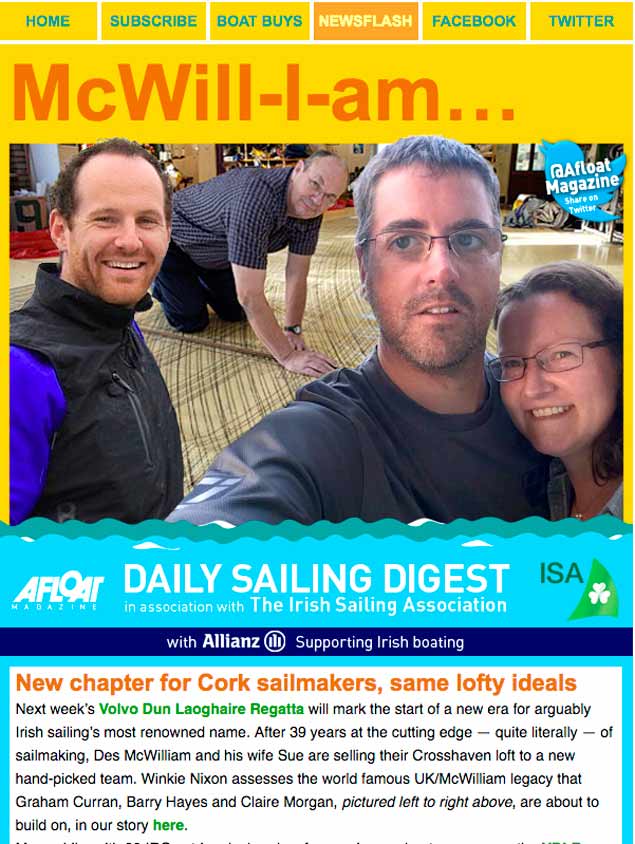 Des McWilliam's retirement and the new team at UK McWilliam in Cork of Barry Hayes, Claire Morgan and Graham Curran featured on Afloat.ie yesterday
Des McWilliam's retirement and the new team at UK McWilliam in Cork of Barry Hayes, Claire Morgan and Graham Curran featured on Afloat.ie yesterday
While Graham is a fast learner who has ascended the rising path in Crosshaven in just three years, and Claire has formidable business and financial skills, it is Barry who is most truly representative of the UK International Sailmakers ethos.
Orginally from Schull, he started in the McWilliam’s Crosshaven loft in 1999 just three years after they’d become associates of UK Sailmakers. Yet within three years he had been invited to join the “mother loft” in New York run by Butch Ulmer, and there he rose to become loft manager.
Then he was recruited from the mother loft to the group’s biggest loft of all, in Hong Kong run by the legendary David Yeung. In his fourteen years there, he has learned everything that David Yeung could teach, and when the great sailmaker finally retired a couple of years ago, it was the young Irishman who took on the role as manager.
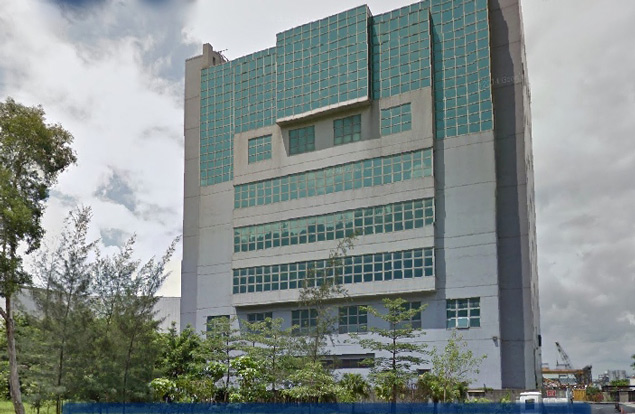 The Hong Kong loft of UK Sailmakers is very typical of the city in which it is located.....
The Hong Kong loft of UK Sailmakers is very typical of the city in which it is located.....
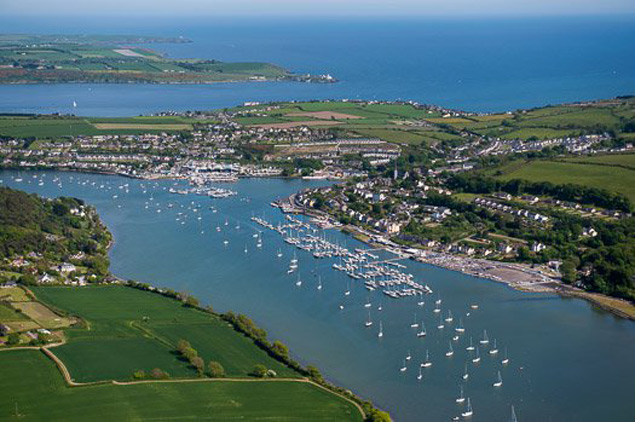 ...which is very different to Crosshaven. Photo: Robert Bateman
...which is very different to Crosshaven. Photo: Robert Bateman
During his time in Hong Kong, Barry Hayes had been at the heart of the loft’s development of titanium sails – among many other projects – so it will be fascinating to see what fresh vistas of development he opens up back in Crosshaven. In other areas of advanced technology, you’d be surprised by the number of specialised Irish outfits – some of them quite small – which are in the forefront of research and development in their own field, so why not Crosshaven and sailmaking?
At the same time, as a sailmaker pure and simple, Barry Hayes has the reputation of being a man who’ll stay up all night beavering away at repairs on your torn mainsail in order that you can sure of getting racing next day, so it’s clear that the loft’s regular everyday customers need not worry that arcane research experiments and developments will distract from the need for traditional sail making and repair services.
And with their considerable combined experience of the McWilliam ethos, and the collegiate outlook of the UK Sailmakers organisation, the new owners will be well aware that the hours will be ridiculous, the miles travelled absurd, and the challenges faced infinite in their variety.
Thus one of my favourite Des McWilliam yarns is of the time he was asked to make sails for the traditional boats of the Achill Yawl type which sail and race on Achill Sound and the nearby waters of Clew Bay. That hero of the Mulranny area, Dr Jerry Crowley, reckoned that a healthy class of Achill yawls regularly sailing in summer would be good for everyone and for community spirit, so he gave every encouragement to getting the fleet into proper action.
 Traditional Achill yawls racing in Achill Sound. With their potentially very powerful rig, when Des McWilliam turned up with new sails, he said it was like putting a Ferrari engine into a Mini
Traditional Achill yawls racing in Achill Sound. With their potentially very powerful rig, when Des McWilliam turned up with new sails, he said it was like putting a Ferrari engine into a Mini
The upshot of it was that as the Celtic Tiger years began to build up a head of steam, every pub along the shores of Achill Sound and anywhere close to the coast nearby found itself sponsoring an Achill Yawl to swell an already considerable privately-owned fleet.
It became increasingly competitive, so inevitably an enquiry was put through to Des McWilliam about making a suit of racing sails, and with one order, others followed. As the Achil yawl sets a powerful lug rig which is as near as you can get to actually being an even more powerful and efficient lateen rig, when Des turned up with a load of max-sized sails at Achill Sound, he asked Jerry Crowley was he aware this would be the equivalent of putting a Ferrari engine into a little old Mini, or even Morris Minor?
This was exactly the impression the owners and skippers wished to make, so the bould Des went off for his first race with the Achill Yawls. They were reaching along in a bunch, and the boat to weather bore down on them until the hulls thumped, and then hauled her wind only the slightest amount.
At the impact Des had called across to the other helmsman: “You can’t do that”. Back came the unanswerable reply: “I just did”. End of conversation.
Within the UK Sailmakers group, Des acquired something of a reputation as an ace specialist in spinnakers, so when America’s Cup legend Dennis Conner out in San Diego asked his local UK Sailmakers loft for a new spinnaker for his personal IRC 50, manager John Bennett passed the order on across America and across the Atlantic to Crosshaven. As Des says, it’s not every day you get an order for a special spinnaker for Dennis Conner, and they gave it the best they could.
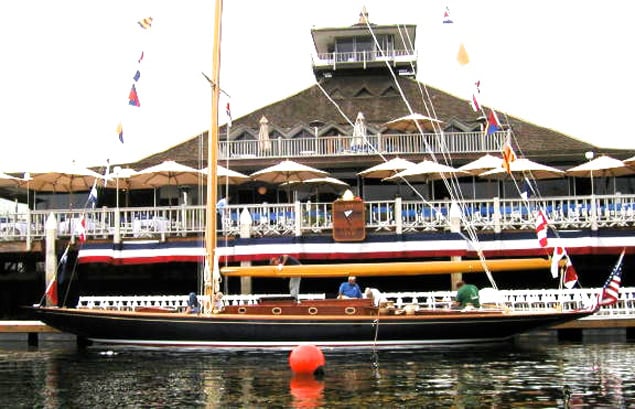 Dennis Conner’s classic Q Class sloop Cotton Blossom II, restored by Johnny Smullen, makes her debut at the San Diego YC. The local UK Sailmakers loft passed along the specific request that Des McWilliam design the spinnakers for the boat
Dennis Conner’s classic Q Class sloop Cotton Blossom II, restored by Johnny Smullen, makes her debut at the San Diego YC. The local UK Sailmakers loft passed along the specific request that Des McWilliam design the spinnakers for the boat
It seems it worked, for when Dun Laoghaire’s own Johnny Smullen restored the classic Q Class Cotton Blossom II in San Diego for Conner, the request came through to Crosshaven for the spinnakers for the re-born boat. It was quite a tricky one says Des, as we had to shape the panels in classic original style.
So the default position in the Crosshaven loft is that the unusual order is the norm. They’re delighted to take on all sorts of challenges, and as founder John McWilliam was originally a fighter jet pilot, in his busiest years with the loft he put his flying skills to good use by having a company plane - a PA 23 Geronimo - for which they didn’t need to hire a pilot to get sails and services as rapidly as possible to customers near and far.
 Dick Newick’s plans for Downtown Flyer, built in a shed in Lisburn, County Antrim
Dick Newick’s plans for Downtown Flyer, built in a shed in Lisburn, County Antrim
However, even by McWilliam standards, the liberation of the trimaran Downtown Flyer from a hidden berth in France was in a league of its own. Downtown Flyer was a 38ft Newick tri built by Brian Law and Dickie Gomes in a shed in Lisburn in Northern Ireland for the 1982 Round Britain and Ireland two-handed race, in which they did mighty well. In fact, they did mighty well in just about every event they entered, and put in such a spectacular showing at the Speed Week in La Trinite in France that when, after a couple of years of very intensive campaigning, they decided to sell, Downtown Flyer was quickly snapped up by a young French skipper who very promptly paid 50% of the purchase price.
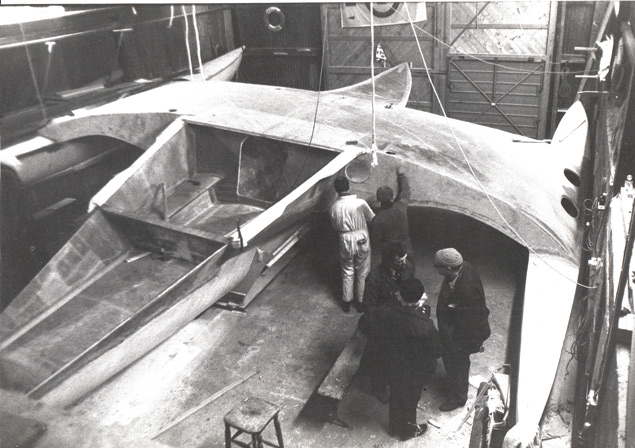 Downtown Flyer under construction in 1982. Her beam was nearly as great as her overall length. Photo W M Nixon
Downtown Flyer under construction in 1982. Her beam was nearly as great as her overall length. Photo W M Nixon
He was so keen to be in place for the next big race in France that the two lads allowed him and his crew to sail the boat away with the promise that the rest of the money would be paid the following week. Weeks passed. Months passed. But money came there none. Recourse to lawyers failed too. They were getting nowhere. But as Johnny McWilliam had made sails for them for a number of craft, he was aware of their predicament, and enthusiastically joined in a project to re-possess the boat.
She was berthed in the heart of a sort of Navy yard in Lorient. But the guys worked out that if they could fly in Johnny’s plane to a little local airfield and implement the plan once night came on, it might just be managed. So they flew down to Brittany and after helping Johnny re-fuel for his fight home by using a local garage and portable tanks so as not to attract official attention, the Liberation Team got to the boat without being noticed as night drew on.
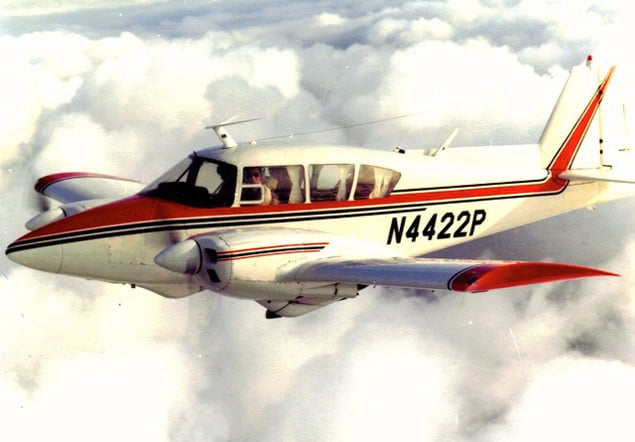 The McWilliam Sailmakers’ PA 23 Geronimo was useful for many tasks, not least a surreal boat liberation
The McWilliam Sailmakers’ PA 23 Geronimo was useful for many tasks, not least a surreal boat liberation
They got away by paddling Downtown Flyer as quietly as possible the length of Lorient Harbour, where they sped away once sail was set. But instead of heading straight for Ireland as any search ship would have expected, they sailed due west into the middle of the Bay of Biscay before turning north for a safe return.
They kept the boat for sale to another purchaser, and in due course the French skipper was given his deposit back. But to receive it, he had to take the Roscoff ferry to Cork to meet the Downtown duo, as they had to return extra equipment that had somehow been added to the boat despite the potential buyer’s supposed penniless state.
In his retirement Johnny has devoted himself to glider flying a a very advanced level, while Des looks forward to getting in some sailing just for fun - he much enjoyed a recent outing with the new sails he made for Guapa, the Bill Trafford-reworked Etchells 22.
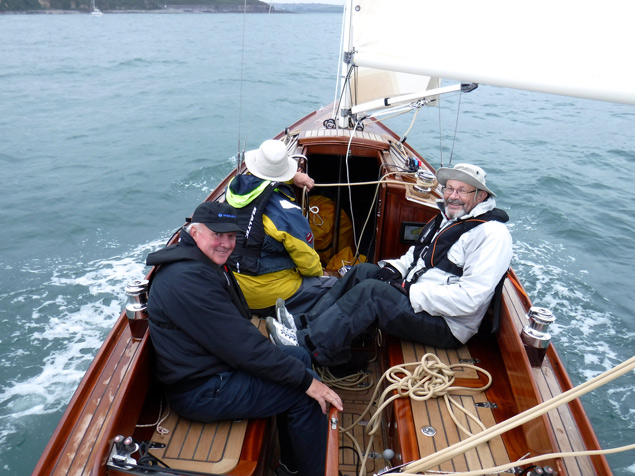 Making a classic suit of sails for the uniquely re-configured Etchells 22 Guapa a month ago was a special pleasure for Des (right) But there’s no doubt that Des’s passion for vintage and classic cars can now come centre stage. It started with a hectic youthful career with vintage motorbikes, but these days he has a sort of compromise with a 1934 Morgan F4 three-wheeler in which he and his wife Sue can take on hill climbs and other vintage car trials with eccentric style.
Making a classic suit of sails for the uniquely re-configured Etchells 22 Guapa a month ago was a special pleasure for Des (right) But there’s no doubt that Des’s passion for vintage and classic cars can now come centre stage. It started with a hectic youthful career with vintage motorbikes, but these days he has a sort of compromise with a 1934 Morgan F4 three-wheeler in which he and his wife Sue can take on hill climbs and other vintage car trials with eccentric style.
 Des and Sue McWilliam in their 1934 vintage Morgan three-wheeler
Des and Sue McWilliam in their 1934 vintage Morgan three-wheeler
In fact, in this little machine, there’s little enough for their comfort when they’re undertaking challenges like the Tim Healy Pass which snakes over the mountains between Bantry Bay and the Kenmare River, but they’re seen doing it with style in this short vid from Easter last year:
The virtue of the Tim Healy event is that afterwards everyone winds their way down from the mountain to the comfort of that noted cruising enthusiasts’ pub, Teddy’s at Kilmakilloge, and the event concludes with a dinner where the attendance on this occasion included nine former Circuit of Ireland winners. But the real winner of the evening was Sue, as she received the Trophy for the Bravest Participant – as that little vid reveals, it was well earned.
Unfortunately, a couple of weeks later while on their way to another vintage car trial, they were the victims of an absent-minded tourist who forgot that we drive on the left in Ireland, and in a serious smash Sue was badly injured. But she’s on the mend, and is looking forward to sharing Des’s new availability for their many interests and family gatherings.
Meanwhile at the Crosshaven loft, the new order of management is already moving into place, and next week will see the UK Sailmakers Crosshaven team present in full strength at the Volvo Dun Laoghaire Regatta. These are very interesting times in sail-making, and the hothouse of competition that Dublin Bay will provide next week is just what’s needed to get fresh ideas to take shape.
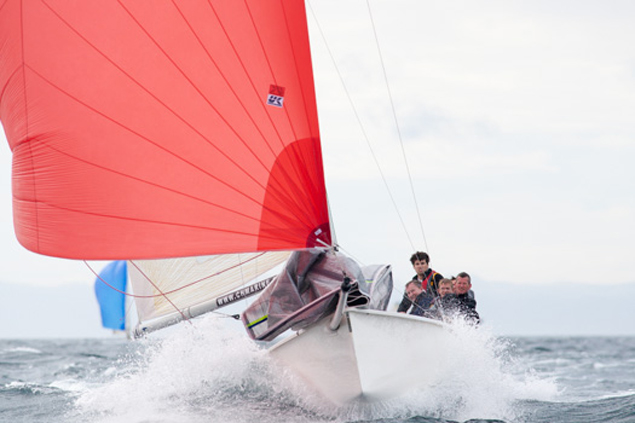 This is what we do. One of the O’Leary Clan’s 1720s burning it up under a new UK Sailmakers asymmetrical kite
This is what we do. One of the O’Leary Clan’s 1720s burning it up under a new UK Sailmakers asymmetrical kite
Leading Irish and international Crosshaven-based sailmakers UK/McWilliam are embarking on a fresh stage of development, with a major change in the company’s ownership structure which will draw on and develop the company’s exceptional range of global activities and expertise, providing customers in Ireland and abroad with an enhanced range of services and products writes W M Nixon.
Sailmaker Des McWilliam is to retire at the end of this year, and is selling the Cork loft to Barry Hayes who started his sailmaking career with the Crosshaven firm, his wife Claire Morgan, and Graham Curran who currently works in the Crosshaven loft.
Since its foundation 43 years ago by noted dinghy and offshore racing champion John McWilliam, the firm has been essentially a McWilliam family enterprise. As the business became established, its picturesque headquarters were created in a skillfully and stylishly re-configured former mill at Hoddersfield in the peaceful countryside immediately inland from Crosshaven in County Cork.
But while the scenery may have been gentle, within the loft the production pace was usually hectic as suits of top class sails were turned out for boats of all kinds which were winning races, both in Ireland and at the highest levels of international competition.
Initially, the core of the workforce was John McWilliam and his wife Diana. But after four years, they were joined by John’s brother Des and his wife Sue. The company’s national and international involvement continued to increase, and in a constantly changing production environment with new and ever more sophisticated fabrics and sailing-making techniques coming into use with rapidly-increasing recourse to CAD/CAM, the company developed a range of international contacts and associations which kept them in the forefront of innovation.
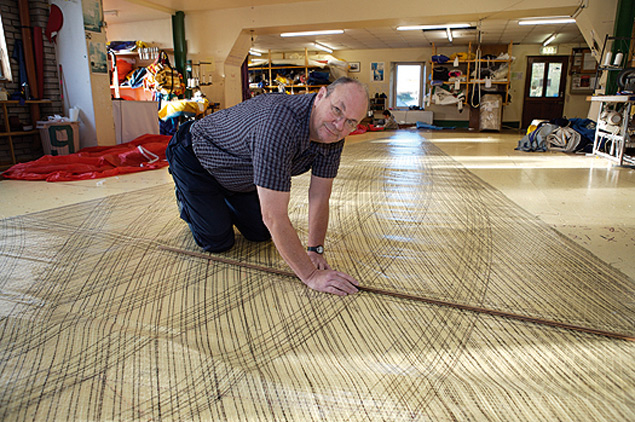 Des McWilliam in the peacefully-located sail loft near Crosshaven. Photo: Robert Bateman
Des McWilliam in the peacefully-located sail loft near Crosshaven. Photo: Robert Bateman
However, although the latest and best in sail-making technology was always to the fore in work on the sail-loft floor, at a marketing level the business was very much built on personal contact and service. The McWilliam brothers and their key employees were always available and enthusiastically willing to show their wide range of customers how to get the best out of their McWilliam sails.
It’s a very demanding if satisfying pace, and after 25 years at the sharp end of world-class sailmaking, John and Diana McWilliam stood down from the leading roles, and for the last 24 years Des McWilliam and a new team of rising talents have been the faces of McWilliam Sailmakers.
The continually evolving environment in which they worked was reflected in the fact that over the years they formed strategic alliances with other sailmakers in order to provide strength in numbers. In 1996 this moved onto a new plane when they became part of the Ulmer Kolius setup, a worldwide group of nearly 50 lofts known as UK Sailmakers, which stemmed originally from a loft established in New York in 1946 by Charlie Ulmer.
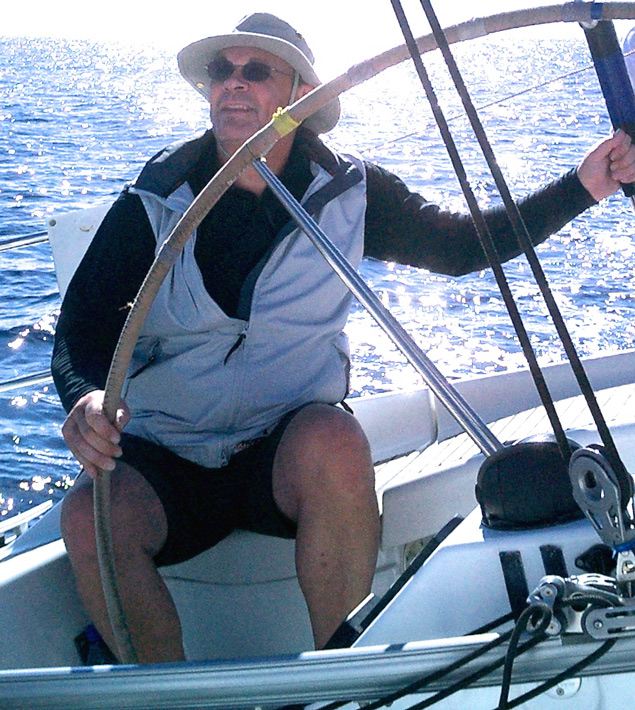 Man at work. Des McWilliam testing the newest suit in his range. In 2011, he was elected in New York for a two year period as global President of UK Sailmakers, a worldwide group with nearly 50 member sail-lofts
Man at work. Des McWilliam testing the newest suit in his range. In 2011, he was elected in New York for a two year period as global President of UK Sailmakers, a worldwide group with nearly 50 member sail-lofts
It says everything for Des McWilliam’s standing in the group that in 2011 at the Annual Meeting in New York, he was elected President of UK Sails in succession to Butch Ulmer himself. This significant honour added to his already hectic work programme, yet for Irish sailors he continued to be the same friendly, informative and ever-willing Des McWilliam, an asset to any boat racing afloat, and the best of company ashore.
But now, after 39 years, he reckons it is time to step down, and by December 2017 he plans to be fully retired. However, he does so in the knowledge that the firm is being taken over by people whom he has trained personally, and who have also benefitted from the worldwide expertise to be gained from being part of the UK Sailmakers Group.
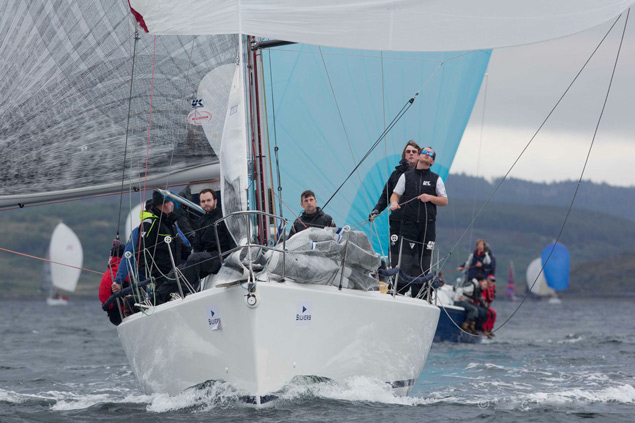 Rob McConnell and Graham Curran trimming Fool’s Gold’s previous UK McWilliam sails at the Scottish Series in Tarbert, in which they are past overall winners. Photo Marc Turner
Rob McConnell and Graham Curran trimming Fool’s Gold’s previous UK McWilliam sails at the Scottish Series in Tarbert, in which they are past overall winners. Photo Marc Turner
The core ownership of the company will now devolve on Barry Hayes and his wife Claire Morgan, and Graham Curran. Of the three, it is Graham Curran who will be best known to today’s generation of front-line sailors in Ireland, as it was he who – working in Crosshaven - master-minded the UK Sailmakers’ new set of threads for Rob McConnell’s A35 Fool’s Gold from Dunmore East for her triumphant line of straight wins in the large Class I in the Sovereigns Cup in Kinsale, concluding last Saturday with Fool’s Gold being the overall champion.
 Pink power. The luminous spinnaker supplied to order for the successful Half Tonner Harmony is such a lurid shade of pink that it colours the sea ahead of the boat. Photo: Robert Bateman
Pink power. The luminous spinnaker supplied to order for the successful Half Tonner Harmony is such a lurid shade of pink that it colours the sea ahead of the boat. Photo: Robert Bateman
Next week in the Volvo Dun Laoghaire Regatta, he’ll be with Jonny Swan of Howth on the classic Half Tonner Harmony, racing as title defenders, but he will of course be available for consultation with the many UK McWilliam clients racing in Ireland’s biggest regatta.
His background is interesting, as he emerged from that increasingly productive nursery of sailing talent, Waterford Harbour SC at Dunmore East. From an early age he was keen to be part of a team racing a bigger boat, rather than a solo Optimist or Laser sailor, and it is this which eventually saw him in a key role on Fool’s Gold. However, while he enjoyed sailing more and more with every campaign, somehow the prospect of being a pro or a yacht designer didn’t quite click with him, so he did a course in Computer Game Development in Limerick University, which unexpectedly yet very happily gave him the skill sets to design sails using computers.
Serendipity played a role, for in April 2014 he found himself having a cup of tea with Des McWilliam, who was keen to recruit new talent, but was adamant that whoever was joining the firm would share its ethos of customer service, involving willingness to work all hours and travel long distances. They struck a spark, and Graham Curran has been an increasingly important element in the Crosshaven loft ever since, his significance belying the fact that he has been there just three years.
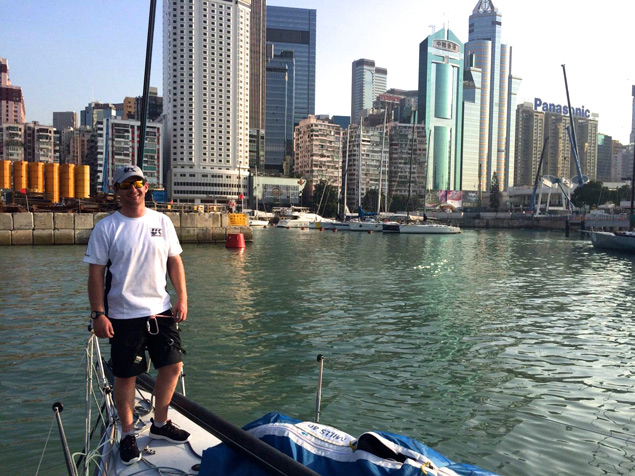 A long way from Crosshaven. Graham Curran in Hong Kong during a visit to the largest UK Sailmakers loft in the world
A long way from Crosshaven. Graham Curran in Hong Kong during a visit to the largest UK Sailmakers loft in the world
The leading figure in the new setup is Barry Hayes, who has been involved with sailmaking for 18 years, gaining unrivalled experience through the UK global network. Originally from Schull, he was introduced to sailing through the remarkable Schull Community College and coaching by Eric Stacy. He went on to third level studies at Dublin Institute of Technolgy, and got into college sailing with team racing and Fireball and Flying Fifteen Racing to national prize-winning level from Dun Laoghaire.
With successful keelboat experience in the Half Tonner King One, he had some breadth of knowledge when he joined McWilliam Sailmakers in 1999, but cheerfully admits that in working with Des McWilliam, his sailing knowledge tripled in jig time as he made sails and campaigned with boats as diverse as J/24s, the legendary Corby 40 Cracklin Rosie, and many others.
In 2002 he was invited to work in the New York loft under the great Butch Ulmer himself, and in his time there he availed of the many opportunities to sail and race on a huge variety of boats. As for experience gained in the business, it was unrivalled, as he became Loft Manager after just one year in the job, all this in time set him up for the next career move, an invitation to join the UK Loft in Hong Kong in 2005.
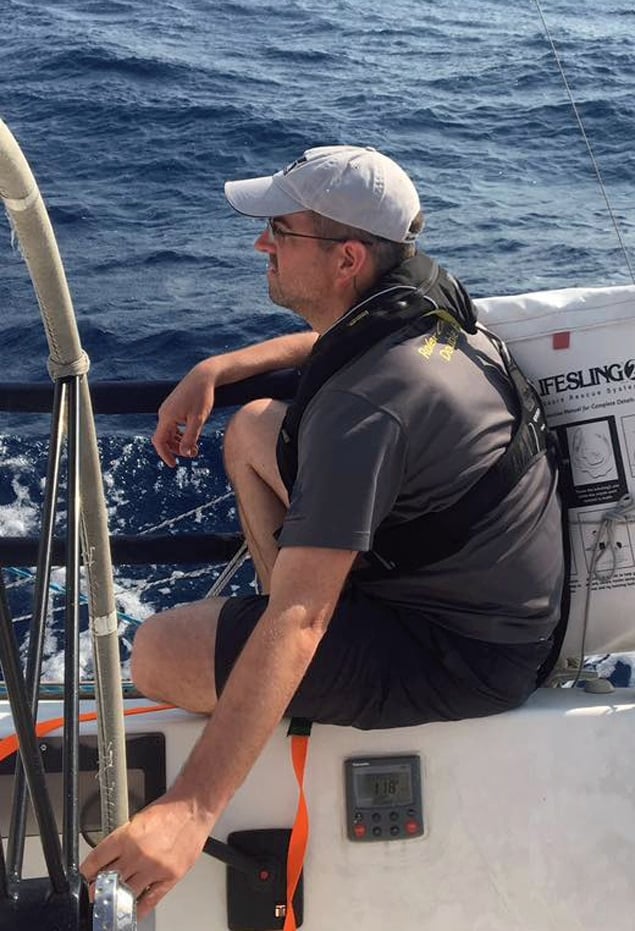 Barry Hayes at the helm
Barry Hayes at the helm
This is the biggest loft in the entire group, and right at the cutting edge of innovation – in 2011, this was where UK started making Titanium sails. It was another significant learning curve for Barry Hayes, as making fully formed sails is not an easy process, but gradually they got on top of the technology, and worked their way upwards from Titanium sails for 30-foooters to using the same method for Maxis, until by 2014 they were making their first Uni Titanium sails incorporating very thin strands of carbon.
He was also sailing frequently on a wide variety of boats on some very exotic races, while on the professional side, he had become a member of the board of directors of UK International, and with the retirement of ace sailmaker David Yeung, he took over the management in Hong Kong of this main production loft for the entire UK group.
But while management is rewarding in itself, there is nothing quite like owning your own operation, and although he’d done very well in Hong Kong, Barry Hayes still felt the call of Ireland and home. So when Des McWilliam floated the possibility of Barry and his wife Claire becoming directly and very personally involved in the business back in Crosshaven, a new direction in their lives began to emerge.
Claire Morgan started sailing at the age of 15 on the south coast of England, and when she went to Cambridge University, it was to study Computer Science. This qualified her for an attractive job in Hong Kong, where she is now a senior manager in HSBC Global Banking and Markets. She resumed sailing, though this time with boats with offshore participation thrown into the equation. She also raced successfully in-harbour with the Etchells 22 and the local class of Ruffian 23s.
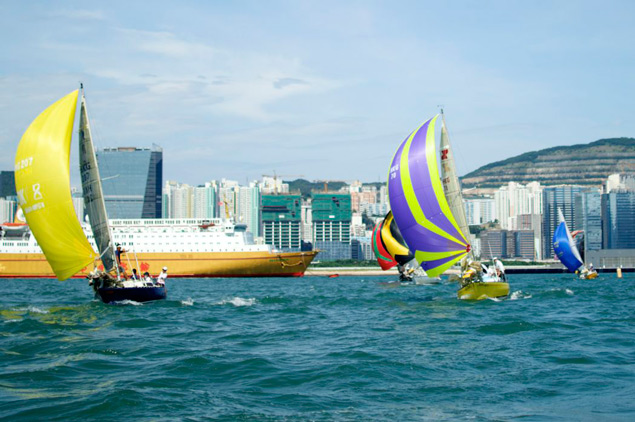 A distant place that will be forever County Down. The Portaferry-built Ruffian 23s continue to be an active class in Hong Kong, and they’re among the boats in which Claire Morgan has achieved success
A distant place that will be forever County Down. The Portaferry-built Ruffian 23s continue to be an active class in Hong Kong, and they’re among the boats in which Claire Morgan has achieved success
But when work permitted (and the work-ethic of Hong Kong is ferocious), Claire was to be found offshore racing in some formidable craft on some very demanding events and frequently at the front of the fleet, so much so that her talents enabled her to take in sailing in Europe including visits to Ireland.
So she is well-informed on what is involved in taking on the ownership and running a leading sail-loft, and hopes that if anything it will increase her sailing opportunities. Certainly the new partnership are mustard keen to build on the UK/McWilliam story and potential, and they undoubtedly have the skill set to do it. As for the remarkable legacy they’re taking on, Des McWilliam has emphasized that while there is indeed a legacy and a notable history, the emphasis has to be on the present and even more on the future, and he has outlined what he sees as the core values of UK/McWilliam:
- People buy from people. Our strength is not technological bullshit, it’s service, quality and people. It’s all people-driven, with a long-standing assurance of service. “Small enough to take care of you, big enough to take care of the opposition”
- We look on ourselves as 30% great history, but 70% great present and great future
- Right now, that 70% is about the new people, the transfer
from me to them, and the immediate success of Graham winning the Sovereign’s Cup last week on Fool’s Gold with sails made by Barry. - While we share the international network, we also pride ourselves on being a proper sail-loft regularly doing in-house designing, cutting, building and servicing of sails for our customers. We are not ‘sailsmen’, we are sailmakers. We don’t pull a handle and pump out another Mermaid mainsail clone, we design each luff curve to suit the individual mast.
- The c.50 sail lofts in the UK International Group are all owned and managed by hands-on sailmakers. No group-think dealerships here. The strength of UK is in sharing our vast accumulated expertise and knowledge. If we come across a new problem, we can quickly source the solution.
- If you don’t need it, we won’t sell you it. Up-selling is not our style.
The newly-formed UK Sailmakers Ireland team will be at Dublin Bay for next week’s Volvo Dun Laoghaire Regatta, and they’re planning to meet customers new, old and potential – and get in some real sailing too. An exciting new chapter is beginning in an already great story.
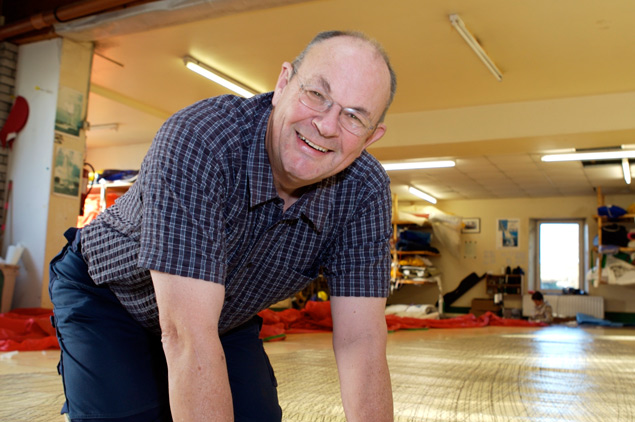 “If you don’t need it, we won’t sell you it. Up-selling is not our style”. Des McWilliam is handing on a clearcut business philosophy. Photo: Robert Bateman
“If you don’t need it, we won’t sell you it. Up-selling is not our style”. Des McWilliam is handing on a clearcut business philosophy. Photo: Robert Bateman




























